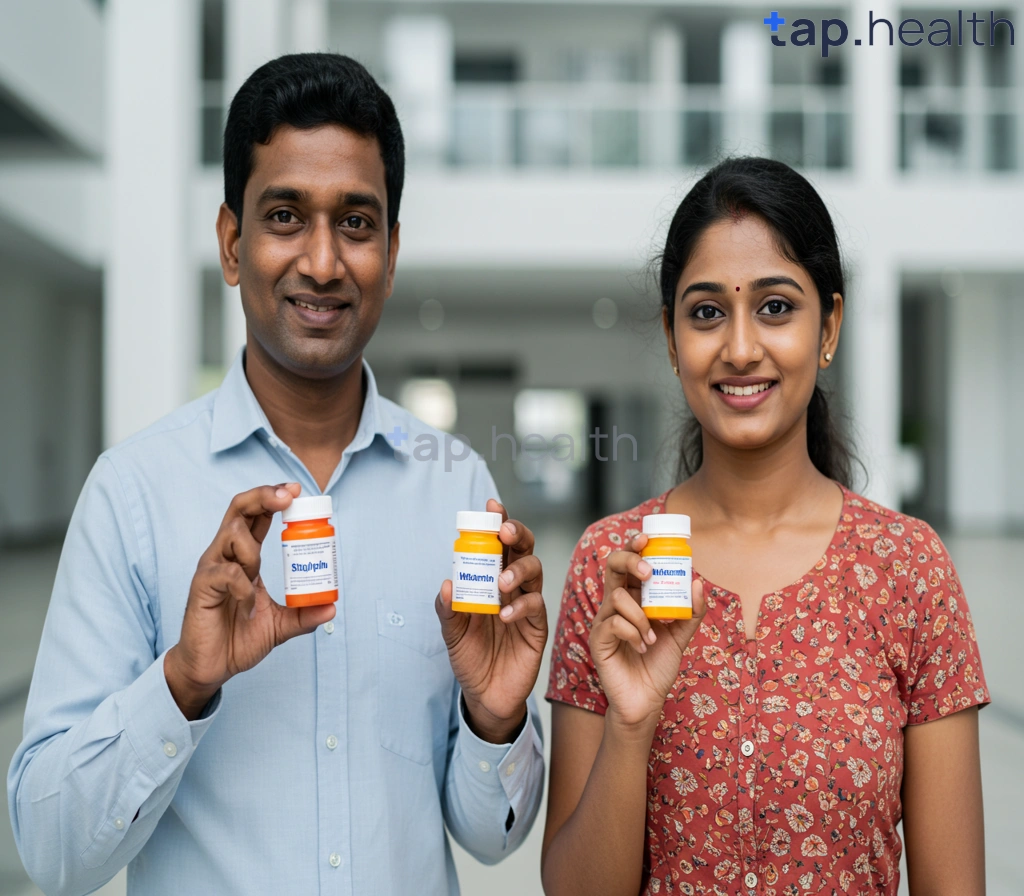Table of Contents
- Understanding Sitagliptin and Metformin: A Complete Guide
- Sitagliptin/Metformin: Dosage, Side Effects & Benefits
- How Effective is Sitagliptin-Metformin for Type 2 Diabetes?
- Sitagliptin and Metformin vs. Other Diabetes Medications
- Is Sitagliptin/Metformin the Right Treatment for You?
- Frequently Asked Questions
- References
Managing type 2 diabetes can feel overwhelming, but understanding your treatment options is a crucial first step. This comprehensive guide dives deep into Sitagliptin and Metformin, a common and effective oral medication combination often prescribed to control blood sugar levels. We’ll explore how this powerful duo works, what to expect during treatment, and address common questions and concerns. Ready to learn more about how Sitagliptin and Metformin: A Comprehensive Guide to Oral Treatment can help you better manage your diabetes? Let’s get started!
Understanding Sitagliptin and Metformin: A Complete Guide
Over 80% of individuals with Type 2 diabetes in India and other tropical countries experience insulin resistance, a key factor contributing to high blood sugar levels. This highlights the importance of effective treatment strategies. Sitagliptin and Metformin, often combined, represent a cornerstone of oral therapy for managing this prevalent condition. Understanding how this combination works is crucial for better diabetes control.
How Sitagliptin and Metformin Work Together
Sitagliptin belongs to a class of drugs called DPP-4 inhibitors. It works by increasing the levels of incretins, hormones that stimulate insulin release after meals. Metformin, on the other hand, is a biguanide that primarily improves insulin sensitivity and reduces glucose production by the liver. This synergistic action makes the combination particularly effective in managing blood sugar levels, especially in individuals with insulin resistance.
Benefits and Considerations for Indian & Tropical Populations
This combination offers several advantages. It’s relatively well-tolerated and can be effective even in patients with moderate renal impairment, a common concern in certain populations. However, it’s crucial to consult your doctor to discuss potential side effects and monitor your kidney function regularly, especially in regions where access to advanced healthcare may be limited. Dietary adjustments, regular exercise, and stress management are also vital for optimal results. Remember, medication is only part of the solution; a holistic approach is key. It’s also important to understand how other medications might interact with your diabetes treatment. For example, you might want to read more about Does Lexapro Affect Diabetic Medicine? Impacts, Risks & Management Tips to understand potential drug interactions.
Taking Control of Your Diabetes
Managing Type 2 diabetes effectively requires a comprehensive approach. Consult your physician to determine if this combination therapy is right for you. Regular monitoring of blood glucose levels, adherence to your treatment plan, and a healthy lifestyle are essential for long-term success in managing your diabetes and improving your overall health and well-being in the Indian and tropical contexts. Understanding the impact of various medications is crucial. For instance, if you’re taking Sertraline, it’s important to be aware of potential dietary restrictions. You can learn more by reading Sertraline Users.
Related Blog Details:
1.
– **Related Blog Title:** Sertraline Users
– **Related Blog Link:** https://tap.health/how-do-i-know-which-foods-to-avoid-sertraline-users/
2.
– **Related Blog Title:** Does Lexapro Affect Diabetic Medicine? Impacts, Risks & Management Tips
– **Related Blog Link:** https://tap.health/does-lexapro-affect-diabetic-medicine/
Sitagliptin/Metformin: Dosage, Side Effects & Benefits
Understanding Sitagliptin and Metformin Combination Therapy
Managing type 2 diabetes effectively often requires a combination approach. Sitagliptin and metformin, frequently combined in a single pill for convenience, represent a powerful dual-action strategy. Sitagliptin, a DPP-4 inhibitor, helps your body release more insulin when blood sugar levels are high. Metformin, a mainstay in diabetes treatment, improves insulin sensitivity and reduces glucose production by the liver. This combination can lead to better blood sugar control than either drug alone, especially crucial in managing the complexities of diabetes in Indian and tropical climates.
Dosage and Considerations
Dosage of sitagliptin/metformin varies significantly depending on individual needs and response to treatment. A doctor will determine the appropriate starting dose and adjust it based on blood sugar monitoring. It’s crucial to follow your doctor’s prescribed dosage and never adjust it without their consultation. Remember that proper dietary management is key alongside medication. For example, aiming for roughly 45–60 grams of carbs per meal, as suggested for many with diabetes, can significantly impact blood sugar levels and overall effectiveness of the treatment. This carbohydrate intake may need adjustments based on individual activity levels and other health factors. Understanding how different medications interact is also important; for instance, you might want to check out information on Can a Diabetic Take Robitussin? if you’re considering taking over-the-counter medications.
Potential Side Effects and Benefits
Common side effects of sitagliptin/metformin can include nausea, diarrhea, vomiting, and stomach upset. However, these are often mild and transient. More serious side effects are rare but necessitate immediate medical attention. The benefits of improved glycemic control, however, often outweigh these risks, significantly reducing the long-term complications associated with poorly managed diabetes, like heart disease, kidney damage, and nerve damage prevalent in many Indian and tropical populations.
Seeking Expert Advice in India and Tropical Regions
Remember: This information is for general knowledge and does not substitute professional medical advice. Consult your doctor or a qualified healthcare professional in India or your respective tropical region to discuss whether sitagliptin/metformin is right for you and to receive personalized dosage recommendations and monitoring. Don’t hesitate to ask questions about managing your diet and lifestyle alongside medication to achieve optimal blood sugar control. While this article focuses on sitagliptin/metformin, understanding other medications is also vital. For example, you might find information on Serdep 100mg: Uses, Benefits and Side Effects helpful in understanding different treatment options.
How Effective is Sitagliptin-Metformin for Type 2 Diabetes?
Type 2 diabetes represents a significant health challenge globally, particularly in India and other tropical countries, where it accounts for approximately 90% of all diabetes cases. Understanding effective treatment options is crucial. Sitagliptin-metformin, a combination oral medication, offers a common approach to managing this prevalent condition. Its effectiveness stems from the synergistic action of its two components.
Understanding the Dual Action
Metformin, a first-line treatment for type 2 diabetes, primarily works by improving insulin sensitivity and reducing glucose production in the liver. Sitagliptin, a dipeptidyl peptidase-4 (DPP-4) inhibitor, enhances the body’s natural incretin hormones, which stimulate insulin release after meals and suppress glucagon secretion. This combined action helps regulate blood sugar levels more effectively than either drug alone.
Efficacy in Indian and Tropical Contexts
While clinical trials show consistent efficacy across diverse populations, factors like lifestyle, diet, and genetic predispositions can influence individual responses to sitagliptin-metformin. In India and tropical countries, factors such as high carbohydrate diets and a sedentary lifestyle may necessitate a more holistic approach to diabetes management, including lifestyle modifications alongside medication. Consulting a physician is essential to determine the appropriate dosage and monitor treatment effectiveness.
Maximizing Treatment Benefits
For optimal results, patients should adhere strictly to their prescribed medication regimen and incorporate regular exercise and a balanced diet into their daily routine. Remember that research highlights the importance of a comprehensive approach to diabetes management. Regular monitoring of blood glucose levels is crucial for assessing treatment effectiveness and making necessary adjustments. Discuss any concerns or challenges with your doctor to develop a personalized diabetes management plan. For those considering alternative approaches, understanding the safety of supplements like those in Is Glucocil Safe for Type 2 Diabetes? is crucial. And, if insulin therapy becomes necessary, learning about What Is The Average Dose Of Insulin For Type 2 Diabetes? – Tap Health can be helpful.
Sitagliptin and Metformin vs. Other Diabetes Medications
Understanding Treatment Options for Type 2 Diabetes
Managing type 2 diabetes effectively requires a personalized approach, and choosing the right medication is crucial. While many oral medications exist, the combination of sitagliptin and metformin stands out for its efficacy and widespread use. This is particularly relevant in India and tropical countries, where type 2 diabetes affects a significant portion of the population, with 61% of those diagnosed being aged between 20-64 years. This highlights the need for accessible and effective treatment options for a younger, working-age demographic.
Comparing Sitagliptin and Metformin with Alternatives
Compared to other treatments like sulfonylureas or insulin, the sitagliptin and metformin combination offers several advantages. Metformin improves insulin sensitivity and reduces glucose production by the liver, while sitagliptin enhances the body’s natural ability to release insulin. This dual action can lead to better blood sugar control than using either drug alone. This is critical in high-risk populations, especially in regions with limited access to specialized healthcare. Other medications may carry higher risks of hypoglycemia or weight gain, factors that are particularly relevant in the context of the Indian and tropical climate. The choice of medication is also heavily influenced by other health conditions. For example, considerations are significantly different for patients with kidney disease, as discussed in our article, Which Diabetes Drug is Best for Diabetics with Kidney Disease?.
Choosing the Right Treatment
The best medication for you will depend on factors like your age, overall health, other medical conditions, and lifestyle. Always consult your doctor to discuss the advantages and disadvantages of sitagliptin and metformin compared to other options. Understanding your individual needs and risk factors is key to making an informed decision about diabetes management. Don’t hesitate to ask your doctor about the suitability of this combination therapy within the context of your specific situation and healthcare access. Early intervention and consistent management are crucial for maintaining good health and preventing long-term complications. Remember that alongside medication, managing your diet plays a crucial role. Learn more about the safe and effective use of dietary supplements in our article, Safe and Effective Dietary Supplements for Diabetes Care.
Is Sitagliptin/Metformin the Right Treatment for You?
Managing type 2 diabetes effectively requires a personalized approach, especially considering the diverse lifestyles and dietary habits prevalent in Indian and tropical countries. The combination of sitagliptin and metformin is a common oral treatment option, but is it the right choice for *you*?
Understanding Sitagliptin/Metformin
This combination medication works by improving your body’s response to insulin and reducing the amount of sugar your liver produces. Sitagliptin helps your body produce more insulin, while metformin helps to improve insulin sensitivity and reduce glucose production by the liver. Effective blood sugar control, as indicated by pre-meal blood sugar levels between 80–130 mg/dL and post-meal levels below 180 mg/dL, is crucial for minimizing long-term complications of diabetes. This combination therapy aims to help you achieve these targets.
Considerations for Indian and Tropical Climates
In regions like India, dietary habits often play a significant role in blood sugar control. High carbohydrate diets, common in many tropical regions, can significantly impact blood sugar levels. Therefore, lifestyle modifications alongside medication are crucial. This includes focusing on a balanced diet rich in fruits and vegetables, incorporating regular exercise, and managing stress levels. Managing side effects from medication is also important; for information on managing other types of medication side effects, you might find Choosing the Right Tablet for Stomach Upset: A Comprehensive Guide – Tap Health helpful.
Is it Right for You?
Ultimately, determining the suitability of sitagliptin/metformin depends on your individual health profile, medical history, and current lifestyle. Consult your doctor to discuss your specific needs, discuss potential side effects and explore this option as part of a comprehensive diabetes management plan. Your physician can assess your blood sugar levels, overall health, and other factors to determine the best course of treatment for optimal health outcomes. Remember, proactive diabetes management is key to a healthier and longer life. While this article focuses on diabetes management, understanding how to choose the right medication for other conditions is also crucial. For instance, if you suffer from migraines, you might find choosing the right migraine tablet informative.
Frequently Asked Questions on Sitagliptin and Metformin
Q1. What is the benefit of combining Sitagliptin and Metformin for type 2 diabetes?
This combination offers several advantages. Sitagliptin increases insulin production, while Metformin improves insulin sensitivity and reduces liver glucose production. This is particularly beneficial for individuals in tropical climates or India with high insulin resistance.
Q2. Are there any side effects or risks associated with this combination therapy?
While generally well-tolerated, regular kidney function monitoring is crucial because of potential renal effects. It’s also important to discuss potential drug interactions with your doctor.
Q3. How does this treatment compare to other type 2 diabetes medications like sulfonylureas or insulin?
Compared to sulfonylureas or insulin, the Sitagliptin/Metformin combination reduces the risk of hypoglycemia (low blood sugar) and weight gain.
Q4. What lifestyle changes should I make to maximize the effectiveness of this treatment?
For optimal results, combine this medication with a healthy diet, regular exercise, and stress management techniques. A holistic approach is key.
Q5. I’m considering this treatment. What should I discuss with my doctor?
Before starting this treatment, discuss your medical history, current medications (to check for interactions), kidney function, and any concerns you may have. Your doctor will help determine if this is the right treatment for you and create a personalized plan, including blood glucose monitoring.
References
- A Practical Guide to Integrated Type 2 Diabetes Care: https://www.hse.ie/eng/services/list/2/primarycare/east-coast-diabetes-service/management-of-type-2-diabetes/diabetes-and-pregnancy/icgp-guide-to-integrated-type-2.pdf
- Diabetes Mellitus: Understanding the Disease, Its Diagnosis, and Management Strategies in Present Scenario: https://www.ajol.info/index.php/ajbr/article/view/283152/266731



